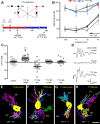In vivo reversible regulation of dendritic patterning by afferent input in bipolar auditory neurons
- PMID: 22895732
- PMCID: PMC3435435
- DOI: 10.1523/JNEUROSCI.1737-12.2012
In vivo reversible regulation of dendritic patterning by afferent input in bipolar auditory neurons
Abstract
Afferent input regulates neuronal dendritic patterning locally and globally through distinct mechanisms. To begin to understand these mechanisms, we differentially manipulate afferent input in vivo and assess effects on dendritic patterning of individual neurons in chicken nucleus laminaris (NL). Dendrites of NL neurons segregate into dorsal and ventral domains, receiving excitatory input from the ipsilateral and contralateral ears, respectively, via nucleus magnocellularis (NM). Blocking action potentials from one ear, by either cochlea removal or temporary treatment with tetrodotoxin (TTX), leads to rapid and significant retraction of affected NL dendrites (dorsal ipsilaterally and ventral contralaterally) within 8 h compared with the other dendrites of the same neurons. The degree of retraction is comparable with that induced by direct deafferentation resulting from transection of NM axons. Importantly, when inner ear activity is allowed to recover from TTX treatments, retracted NL dendrites regrow to their normal length within 48 h. The retraction and growth involve elimination of terminal branches and addition of new branches, respectively. Examination of changes in NL dendrites at 96 h after unilateral cochlea removal, a manipulation that induces cell loss in NM and persistent blockage of afferent excitatory action potentials, reveals a significant correlation between cell death in the ipsilateral NM and the degree of dendritic retraction in NL. These results demonstrate that presynaptic action potentials rapidly and reversibly regulate dendritic patterning of postsynaptic neurons in a compartment specific manner, whereas long-term dendritic maintenance may be regulated in a way that is correlated with the presence of silent presynaptic appositions.
Figures






Similar articles
-
Rapid regulation of microtubule-associated protein 2 in dendrites of nucleus laminaris of the chick following deprivation of afferent activity.Neuroscience. 2008 Jun 12;154(1):381-9. doi: 10.1016/j.neuroscience.2008.02.032. Epub 2008 Feb 29. Neuroscience. 2008. PMID: 18440716 Free PMC article.
-
Compartment-specific regulation of plasma membrane calcium ATPase type 2 in the chick auditory brainstem.J Comp Neurol. 2009 Jun 20;514(6):624-40. doi: 10.1002/cne.22045. J Comp Neurol. 2009. PMID: 19365819 Free PMC article.
-
Activity-dependent synaptic integration and modulation of bilateral excitatory inputs in an auditory coincidence detection circuit.J Physiol. 2018 May 15;596(10):1981-1997. doi: 10.1113/JP275735. Epub 2018 Apr 16. J Physiol. 2018. PMID: 29572827 Free PMC article.
-
Relative input strength rapidly regulates dendritic structure of chick auditory brainstem neurons.J Comp Neurol. 2011 Oct 1;519(14):2838-51. doi: 10.1002/cne.22656. J Comp Neurol. 2011. PMID: 21500196 Free PMC article.
-
The analysis of interaural time differences in the chick brain stem.Physiol Behav. 2005 Oct 15;86(3):297-305. doi: 10.1016/j.physbeh.2005.08.003. Epub 2005 Oct 3. Physiol Behav. 2005. PMID: 16202434 Free PMC article. Review.
Cited by
-
Distinct Neural Properties in the Low-Frequency Region of the Chicken Cochlear Nucleus Magnocellularis.eNeuro. 2017 Apr 11;4(2):ENEURO.0016-17.2017. doi: 10.1523/ENEURO.0016-17.2017. eCollection 2017 Mar-Apr. eNeuro. 2017. PMID: 28413822 Free PMC article.
-
Temporal-specific roles of fragile X mental retardation protein in the development of the hindbrain auditory circuit.Development. 2020 Aug 25;147(21):dev188797. doi: 10.1242/dev.188797. Development. 2020. PMID: 32747436 Free PMC article.
-
Resolution of interaural time differences in the avian sound localization circuit-a modeling study.Front Comput Neurosci. 2014 Aug 26;8:99. doi: 10.3389/fncom.2014.00099. eCollection 2014. Front Comput Neurosci. 2014. PMID: 25206329 Free PMC article.
-
Proteomic analyses of nucleus laminaris identified candidate targets of the fragile X mental retardation protein.J Comp Neurol. 2017 Oct 15;525(15):3341-3359. doi: 10.1002/cne.24281. Epub 2017 Jul 24. J Comp Neurol. 2017. PMID: 28685837 Free PMC article.
-
Intense and specialized dendritic localization of the fragile X mental retardation protein in binaural brainstem neurons: a comparative study in the alligator, chicken, gerbil, and human.J Comp Neurol. 2014 Jun 15;522(9):2107-28. doi: 10.1002/cne.23520. J Comp Neurol. 2014. PMID: 24318628 Free PMC article.
References
-
- Abercrombie M. Estimation of nuclear population from microtome sections. Anat Rec. 1946;94:239–247. - PubMed
-
- Benes FM, Parks TN, Rubel EW. Rapid dendritic atrophy following deafferentation: an EM morphometric analysis. Brain Res. 1977;122:1–13. - PubMed
-
- Born DE, Rubel EW. Afferent influences on brain stem auditory nuclei of the chicken: neuron number and size following cochlea removal. J Comp Neurol. 1985;231:435–445. - PubMed
-
- Born DE, Durham D, Rubel EW. Afferent influences on brainstem auditory nuclei of the chick: nucleus magnocellularis neuronal activity following cochlea removal. Brain Res. 1991;557:37–47. - PubMed
Publication types
MeSH terms
Substances
Grants and funding
LinkOut - more resources
Full Text Sources
Miscellaneous
